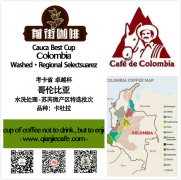The Vera Satchi coffee bean from Yelsa processing plant ranked third in Costa Rica COE.
Costa Rica can be said to be a model for the production of micro-batches of high-quality coffee raw beans, and farmers' living standards are much higher than those in other coffee-producing regions. About a decade ago, small-scale coffee farmers in Costa Rica started a revolution in microprocessing plants to set up their own processing plants to distinguish them from mass-produced commercial beans, to improve the quality and identification of raw coffee beans, and to obtain good selling prices.
The highly technical nature of Costa Rican farmers gives them a great advantage in producing better coffee. They have been tested with different varieties, such as SL-28, Rosa / Geisha, Caturra, Typica. Most coffee farms have high tree density, are fully fertilized, and give farmers higher returns all the year round, and their coffee trees are constantly being renewed, as well. Finally, they choose cherry blossoms that are very good and perfect in some cases.
The well-known Yelsa processing plant can already be regarded as a medium-sized processing plant by local Costa Rican standards. in addition to handling coffee produced by its own farm Santa Lucia, the Yelsa processing plant also handles coffee cherries produced by high-quality small farmers in micro-producing areas such as West Valley Lourdes de Naranjo and Llano Bonito de Naranjo. Yelsa treatment plant was established in 2004, due to the operator's persistence, the quality improvement is very fast, become famous is also very fast, 2007 won the third place in Costa Rica COE.

Important Notice :
前街咖啡 FrontStreet Coffee has moved to new addredd:
FrontStreet Coffee Address: 315,Donghua East Road,GuangZhou
Tel:020 38364473
- Prev

Colombia Huilan micro-batch boutique coffee producing area San Augustine Castillo Catura
The natural geographical environment of the Colombian Andes, a new product of coffee, the unique pozzolanic soil of the region and carefully cultivated and refined artificial processing have created the outstanding performance of this bean in the cup: the strong aroma and personality is an ingenious blend of fresh acidity, almonds and cocoa aromas that stimulate taste buds like grapes. the bright acidity in the sweet tone of the entrance is elegant and bright, mellow.
- Next

Raw beans Wholesale Price Coffee roasting Columbia Huila Micro batch microlot
The natural geographical environment of the Colombian Andes, a new product of coffee, the unique pozzolanic soil of the region and carefully cultivated and refined artificial processing have created the outstanding performance of this bean in the cup: the strong aroma and personality is an ingenious blend of fresh acidity, almonds and cocoa aromas that stimulate taste buds like grapes. the bright acidity in the sweet tone of the entrance is elegant and bright, mellow.
Related
- Detailed explanation of Jadeite planting Land in Panamanian Jadeite Manor introduction to the grading system of Jadeite competitive bidding, Red bid, Green bid and Rose Summer
- Story of Coffee planting in Brenka region of Costa Rica Stonehenge Manor anaerobic heavy honey treatment of flavor mouth
- What's on the barrel of Blue Mountain Coffee beans?
- Can American coffee also pull flowers? How to use hot American style to pull out a good-looking pattern?
- Can you make a cold extract with coffee beans? What is the right proportion for cold-extracted coffee formula?
- Indonesian PWN Gold Mandrine Coffee Origin Features Flavor How to Chong? Mandolin coffee is American.
- A brief introduction to the flavor characteristics of Brazilian yellow bourbon coffee beans
- What is the effect of different water quality on the flavor of cold-extracted coffee? What kind of water is best for brewing coffee?
- Why do you think of Rose Summer whenever you mention Panamanian coffee?
- Introduction to the characteristics of authentic blue mountain coffee bean producing areas? What is the CIB Coffee Authority in Jamaica?

